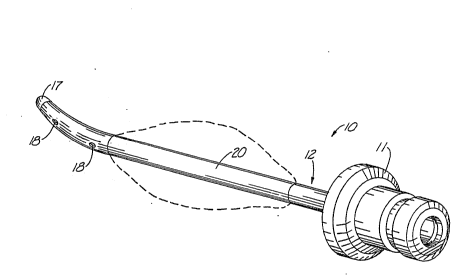Une partie des informations de ce site Web a été fournie par des sources externes. Le gouvernement du Canada n'assume aucune responsabilité concernant la précision, l'actualité ou la fiabilité des informations fournies par les sources externes. Les utilisateurs qui désirent employer cette information devraient consulter directement la source des informations. Le contenu fourni par les sources externes n'est pas assujetti aux exigences sur les langues officielles, la protection des renseignements personnels et l'accessibilité.
L'apparition de différences dans le texte et l'image des Revendications et de l'Abrégé dépend du moment auquel le document est publié. Les textes des Revendications et de l'Abrégé sont affichés :
| (12) Brevet: | (11) CA 1313803 |
|---|---|
| (21) Numéro de la demande: | 605549 |
| (54) Titre français: | DISPOSITIF D'INJECTION UTERINE AVEC TUBE GONFLABLE ET CANAL UNIQUE |
| (54) Titre anglais: | SINGLE CHANNEL BALLOON UTERINE INJECTOR |
| Statut: | Réputé périmé |
| (52) Classification canadienne des brevets (CCB): |
|
|---|---|
| (51) Classification internationale des brevets (CIB): |
|
| (72) Inventeurs : |
|
| (73) Titulaires : |
|
| (71) Demandeurs : | |
| (74) Agent: | |
| (74) Co-agent: | |
| (45) Délivré: | 1993-02-23 |
| (22) Date de dépôt: | 1989-07-13 |
| Licence disponible: | S.O. |
| (25) Langue des documents déposés: | Anglais |
| Traité de coopération en matière de brevets (PCT): | Non |
|---|
| (30) Données de priorité de la demande: | S.O. |
|---|
-9-
Abstract of the Disclosure
An apparatus for injection of dye or contrast
medium into a uterine cavity. An elongated member
having a first and a second end and an intermediate
portion has a liquid impervious expandable tube
disposed around it and is sealed on each end thereof to
the exterior thereof. A first fluid passageway extends
from one end of the elongated member to a barrier and
another fluid passageway extends from the other end of
the elongated member to the barrier. A first opening
in the elongated member allows fluid communication
between the first passageway and the inside of the
balloon tube and a second opening in the elongated
member provides fluid communication between the second
fluid passageway and the inside of the balloon tube.
The second opening is substantially smaller in
cross-sectional area than the first opening whereby
fluid pressure applied to the first passageway will
remain substantially higher than the pressure in the
second fluid communication passageway, whereby fluid
pressure within the tube will cause it to expand to
seal against the inner wall of the uterine cavity,
while at the same time fluid will flow sequentially
from the first fluid communication passageway, through
the first opening, through the expanded balloon tube,
through the second opening, through the second
communication passageway and out through a discharge
opening structure on one end of the second fluid
communication passageway.
Note : Les revendications sont présentées dans la langue officielle dans laquelle elles ont été soumises.
Note : Les descriptions sont présentées dans la langue officielle dans laquelle elles ont été soumises.

Pour une meilleure compréhension de l'état de la demande ou brevet qui figure sur cette page, la rubrique Mise en garde , et les descriptions de Brevet , États administratifs , Taxes périodiques et Historique des paiements devraient être consultées.
| Titre | Date |
|---|---|
| Date de délivrance prévu | 1993-02-23 |
| (22) Dépôt | 1989-07-13 |
| (45) Délivré | 1993-02-23 |
| Réputé périmé | 2002-02-25 |
Il n'y a pas d'historique d'abandonnement
| Type de taxes | Anniversaire | Échéance | Montant payé | Date payée |
|---|---|---|---|---|
| Le dépôt d'une demande de brevet | 0,00 $ | 1989-07-13 | ||
| Taxe de maintien en état - brevet - ancienne loi | 2 | 1995-02-23 | 50,00 $ | 1995-04-18 |
| Taxe de maintien en état - brevet - ancienne loi | 3 | 1996-02-23 | 50,00 $ | 1995-12-08 |
| Taxe de maintien en état - brevet - ancienne loi | 4 | 1997-02-24 | 250,00 $ | 1997-12-30 |
| Taxe de maintien en état - brevet - ancienne loi | 5 | 1998-02-23 | 75,00 $ | 1997-12-30 |
| Taxe de maintien en état - brevet - ancienne loi | 6 | 1999-02-23 | 75,00 $ | 1998-12-10 |
| Taxe de maintien en état - brevet - ancienne loi | 7 | 2000-02-23 | 75,00 $ | 1999-01-20 |
Les titulaires actuels et antérieures au dossier sont affichés en ordre alphabétique.
| Titulaires actuels au dossier |
|---|
| VALTCHEV, KONSTANTIN LAZAROV |
| Titulaires antérieures au dossier |
|---|
| S.O. |